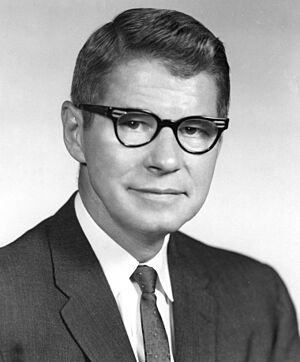Orville Freeman facts for kids
Quick facts for kids
Orville Freeman
|
|
|---|---|
 |
|
| 16th United States Secretary of Agriculture | |
| In office January 21, 1961 – January 20, 1969 |
|
| President | John F. Kennedy Lyndon B. Johnson |
| Preceded by | Ezra Taft Benson |
| Succeeded by | Clifford M. Hardin |
| 29th Governor of Minnesota | |
| In office January 5, 1955 – January 2, 1961 |
|
| Lieutenant | Karl Rolvaag |
| Preceded by | C. Elmer Anderson |
| Succeeded by | Elmer L. Andersen |
| Personal details | |
| Born |
Orville Lothrop Freeman
May 9, 1918 Minneapolis, Minnesota, U.S. |
| Died | February 20, 2003 (aged 84) Minneapolis, Minnesota, U.S. |
| Resting place | Lakewood Cemetery |
| Political party | Democratic |
| Spouse |
Jane Shields
(m. 1942) |
| Children | 2, including Michael |
| Education | University of Minnesota (BA, LLB) |
| Military service | |
| Branch/service | United States Marine Corps |
| Rank | Major |
| Battles/wars | World War II • Battle of Bougainville |
Orville Lothrop Freeman (May 9, 1918 – February 20, 2003) was an American politician. He was a member of the Democratic Party. Freeman served as the 29th Governor of Minnesota from 1955 to 1961. Later, he became the U.S. secretary of agriculture from 1961 to 1969. He worked under Presidents John F. Kennedy and Lyndon B. Johnson. Freeman helped create the Minnesota Democratic–Farmer–Labor Party. This party was formed by combining two older parties. He also nominated John F. Kennedy for president in 1960.
Contents
Early Life and Education
Orville Freeman was born on May 9, 1918, in Minneapolis, Minnesota. His parents were Orville and Frances Freeman. His grandfather had moved from Sweden to a farm in Minnesota.
Orville went to Central High School in Minneapolis. In 1940, he graduated with high honors from the University of Minnesota. He played football there as a reserve quarterback. At college, he met his lifelong friend and political partner, Hubert Humphrey. He also met his future wife, Jane Charlotte Shields. They got married on May 2, 1942, and had two children.
Military Service in World War II
Freeman joined the Marine Forces Reserve in 1940. He knew the United States might join World War II. He planned to finish law school first. However, the attack on Pearl Harbor changed his plans. On December 31, 1941, he was ordered to report for Officer Candidate School.
After training, Freeman became an infantry officer. He was assigned to the 9th Marine Regiment. His unit went overseas for training in New Zealand and Guadalcanal.
On November 1, 1943, Freeman experienced his first combat. His unit landed at Torokina on Bougainville. This was part of the Bougainville Campaign. A few days later, while leading a patrol, he faced some Japanese soldiers. During the fight, Freeman was wounded in his jaw and left arm. He was sent to a hospital and then returned to the U.S. in 1944. He never fully recovered enough to return to combat duty.
Political Career Highlights
Freeman earned his law degree from the University of Minnesota Law School in 1946. He then worked as a lawyer in Minneapolis. He also helped lead the new Minnesota Democratic-Farmer-Labor Party. He was a political helper for his college friend, Hubert Humphrey, who was then the mayor of Minneapolis. Freeman also managed Humphrey's successful campaign for the United States Senate in 1948.
He ran for Attorney General of Minnesota in 1950 but did not win. He also ran for governor in 1952 and lost.
Serving as Governor of Minnesota
Freeman was elected governor in 1954. He was the first DFL governor of Minnesota. He was reelected in 1956 and 1958.
In 1959, he took an unusual step. He declared martial law in the city of Albert Lea. This was to keep order during a worker strike. After 12 days, a federal court decided that martial law was not needed.
In July 1960, Freeman gave a speech to nominate U.S. Senator John F. Kennedy for president. This happened at the 1960 Democratic National Convention.
U.S. Secretary of Agriculture
After losing his reelection for governor in 1960, Freeman was appointed to a new role. President Kennedy chose him as the U.S. Secretary of Agriculture. He continued in this job under President Lyndon B. Johnson. He served until January 21, 1969.
Later Life and Legacy
After his time in government, Freeman led two consulting businesses. He also practiced law in Washington, D.C.. He was the president and CEO of Business International Corporation from 1970 to 1985.
Orville Freeman passed away on February 20, 2003, in Minneapolis. He died from complications of Alzheimer's disease. He was buried in Lakewood Cemetery in Minneapolis.
Freeman is remembered for suggesting the Food Stamp Program. This program helps people in need buy food. It is still used today.
His son, Mike Freeman, also became a politician. He served as the County Attorney for Hennepin County, Minnesota for many years.
Awards and Decorations
Freeman received several awards and medals for his military service:
| Purple Heart | Asiatic-Pacific Campaign Medal w/ service star | World War II Victory Medal |
See also
- List of notable United States Marines


